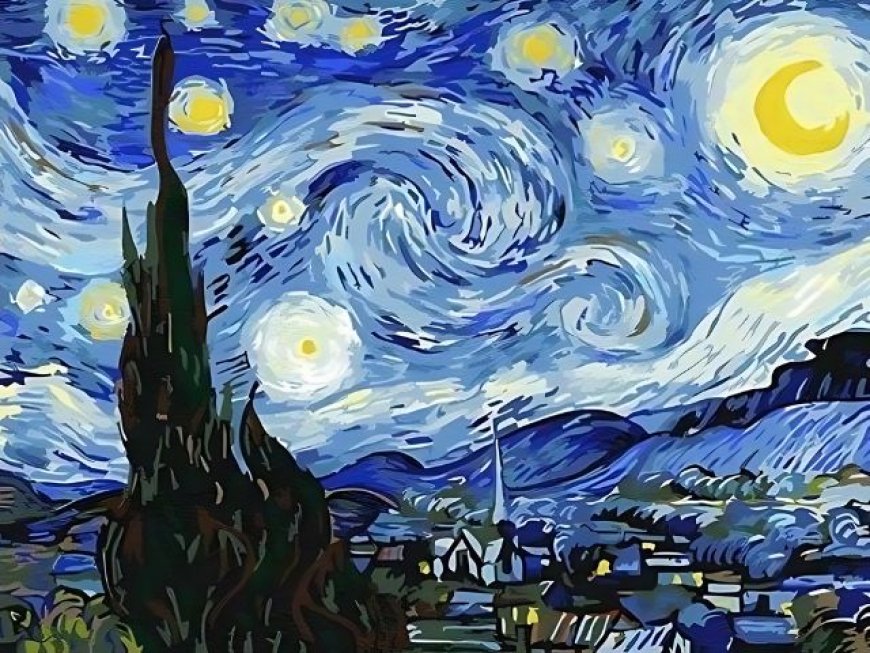The Starry Night
Vincent van Gogh’s The Starry Night is one of the most iconic paintings in the world, capturing the imagination of art lovers and casual observers alike. Painted in 1889 while Van Gogh was staying at the Saint-Paul-de-Mausole asylum in Saint-Rémy-de-Provence, the artwork represents a vivid blend of reality, memory, and fantasy. More than just a depiction of the night sky, The Starry Night is a window into the artist’s inner world, filled with emotion, spirituality, and longing.

Vincent van Gogh’s Journey Through Emotion and Imagination
Vincent van Gogh’s The Starry Night is one of the most iconic paintings in the world, capturing the imagination of art lovers and casual observers alike. Painted in 1889 while Van Gogh was staying at the Saint-Paul-de-Mausole asylum in Saint-Rémy-de-Provence, the artwork represents a vivid blend of reality, memory, and fantasy. More than just a depiction of the night sky, The Starry Night is a window into the artist’s inner world, filled with emotion, spirituality, and longing.
The Artistic Techniques Behind The Starry Night
1. Swirling Brushstrokes
Van Gogh’s distinctive swirling brushstrokes give the painting a sense of motion and energy. The rolling sky appears alive, with stars and the moon radiating a luminous glow that contrasts with the stillness of the village below.
2. Use of Color
Van Gogh used a vibrant yet limited color palette dominated by deep blues and bright yellows. The stark contrast between these colors creates a dreamy, almost surreal quality, emphasizing the painting’s emotional intensity.
3. Impasto Technique
The thick application of paint, known as impasto, adds texture and dimension to the canvas. The layered paint creates a tactile surface, giving viewers a sense of the artist’s physical engagement with his work.
4. Composition and Balance
The painting juxtaposes the cosmic grandeur of the swirling sky with the grounded serenity of the village. The cypress tree in the foreground acts as a bridge between these two realms, its dark, flame-like form reaching towards the heavens.
5. Perspective and Depth
Van Gogh achieved depth by layering the foreground, middle ground, and background. The cypress tree and village provide a grounded frame, while the hills and sky recede into an infinite, otherworldly expanse.
The Meaning Behind The Starry Night
1. Inner Turmoil and Peace
Van Gogh painted The Starry Night during a time of personal struggle, yet the artwork conveys both chaos and serenity. The swirling sky reflects the artist’s emotional turbulence, while the peaceful village represents a longing for stability.
2. Spiritual Connection
The painting has often been interpreted as a spiritual exploration. The cypress tree, commonly associated with death in European art, reaches toward the sky, suggesting a connection between the earthly and the divine.
3. Inspired by Nature and Memory
Although Van Gogh painted The Starry Night while confined to the asylum, he drew inspiration from his observations of the night sky and his memories of his hometown. The result is a blend of reality and imagination.
Fun Facts About The Starry Night
-
Painted From a Window
Van Gogh painted the scene from the window of his room at the asylum, but he added imaginary elements like the swirling stars and the towering cypress tree. -
It Wasn't His Favorite
Van Gogh himself was critical of the painting, calling it an exaggeration. He considered it less successful than some of his other works, such as The Night Café. -
Cultural Influence
The Starry Night has inspired countless adaptations, from Don McLean’s song "Vincent" to parodies and reinterpretations in popular culture. -
Scientific Accuracy
Astronomers have studied the painting and noted its resemblance to actual celestial phenomena, including spiral galaxies and turbulent airflows. -
A Painting of Hope
Despite its turbulent sky, The Starry Night radiates a sense of hope. The glowing lights of the village and stars remind viewers of the beauty and persistence of life.
Legacy and Cultural Impact
The Starry Night is housed at the Museum of Modern Art (MoMA) in New York City, where it attracts millions of visitors each year. Its universal themes of emotion, nature, and spirituality make it a timeless masterpiece. Van Gogh’s unique vision and technique continue to inspire artists and viewers, proving that beauty can emerge from even the darkest moments.
Vincent van Gogh’s The Starry Night is more than a painting—it is a reflection of the human condition. Through its dynamic brushstrokes, vibrant colors, and profound symbolism, it invites viewers to explore their own emotions and connect with the vast, mysterious universe. Whether you see chaos, peace, or hope, The Starry Night leaves an indelible impression on all who gaze upon it.
What's Your Reaction?





















